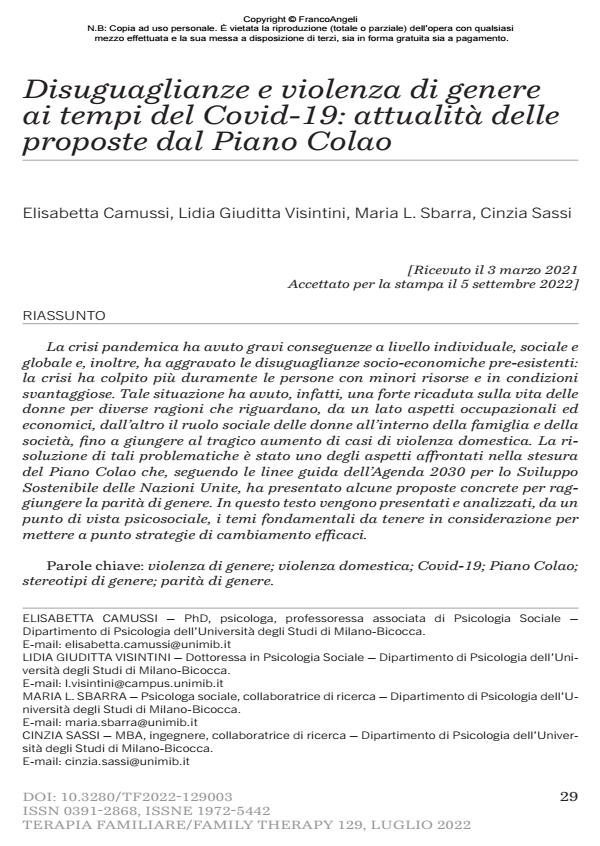Disuguaglianze e violenza di genere ai tempi del Covid-19: attualità delle proposte dal Piano Colao
Titolo Rivista TERAPIA FAMILIARE
Autori/Curatori Elisabetta Camussi, Lidia Giuditta Visintini, Maria L. Sbarra, Cinzia Sassi
Anno di pubblicazione 2022 Fascicolo 2022/129
Lingua Italiano Numero pagine 22 P. 29-50 Dimensione file 735 KB
DOI 10.3280/TF2022-129003
Il DOI è il codice a barre della proprietà intellettuale: per saperne di più
clicca qui
Qui sotto puoi vedere in anteprima la prima pagina di questo articolo.
Se questo articolo ti interessa, lo puoi acquistare (e scaricare in formato pdf) seguendo le facili indicazioni per acquistare il download credit. Acquista Download Credits per scaricare questo Articolo in formato PDF

FrancoAngeli è membro della Publishers International Linking Association, Inc (PILA)associazione indipendente e non profit per facilitare (attraverso i servizi tecnologici implementati da CrossRef.org) l’accesso degli studiosi ai contenuti digitali nelle pubblicazioni professionali e scientifiche
La crisi pandemica ha avuto gravi conseguenze a livello individuale, sociale e globale e, inoltre, ha aggravato le disuguaglianze socio-economiche pre-esistenti: la crisi ha colpito più duramente le persone con minori risorse e in condizioni svantaggiose. Tale situazione ha avuto, infatti, una forte ricaduta sulla vita delle donne per diverse ragioni che riguardano, da un lato aspetti occupazionali ed economici, dall’altro il ruolo sociale delle donne all’interno della famiglia e della società, fino a giungere al tragico aumento di casi di violenza domestica. La risoluzione di tali problematiche è stato uno degli aspetti affrontati nella stesura del Piano Colao che, seguendo le linee guida dell’Agenda 2030 per lo Sviluppo Sostenibile delle Nazioni Unite, ha presentato alcune proposte concrete per raggiungere la parità di genere. In questo testo vengono presentati e analizzati, da un punto di vista psicosociale, i temi fondamentali da tenere in considerazione per mettere a punto strategie di cambiamento efficaci.
Parole chiave:violenza di genere; violenza domestica; Covid-19; Piano Colao; stereotipi di genere; parità di genere.
Elisabetta Camussi, Lidia Giuditta Visintini, Maria L. Sbarra, Cinzia Sassi, Disuguaglianze e violenza di genere ai tempi del Covid-19: attualità delle proposte dal Piano Colao in "TERAPIA FAMILIARE" 129/2022, pp 29-50, DOI: 10.3280/TF2022-129003